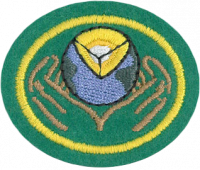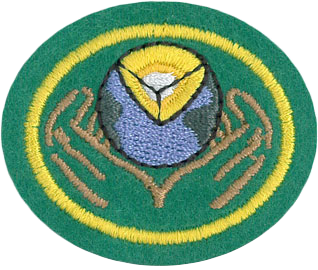Difference between revisions of "AY Honors/Geological Geocaching/Answer Key"
m |
|||
| (12 intermediate revisions by 3 users not shown) | |||
| Line 1: | Line 1: | ||
| − | {{ | + | {{HonorSubpage}} |
| − | | | + | <!--{{Honor Master|honor={{#titleparts:{{PAGENAME}}|1|3}}|master=Recreation}}--> |
| − | | | + | <section begin="Body" /> |
| − | + | {{ansreq|page={{#titleparts:{{PAGENAME}}|2|1}}|num=1}} | |
| − | | | + | <noinclude><translate><!--T:14--> |
| − | | | + | </noinclude> |
| − | | | + | <!-- 1. Earn the Geology or Rocks and Minerals Honor. --> |
| − | | | ||
| − | }} | ||
| − | |||
{{honor_prerequisite|category=Nature|honor=Geology}} | {{honor_prerequisite|category=Nature|honor=Geology}} | ||
{{honor_prerequisite|category=Nature|honor=Rocks & Minerals}} | {{honor_prerequisite|category=Nature|honor=Rocks & Minerals}} | ||
| − | ==2. Earn the Geocaching Honor | + | <noinclude></translate></noinclude> |
| + | {{CloseReq}} <!-- 1 --> | ||
| + | {{ansreq|page={{#titleparts:{{PAGENAME}}|2|1}}|num=2}} | ||
| + | <noinclude><translate><!--T:15--> | ||
| + | </noinclude> | ||
| + | <!-- 2. Earn the Geocaching Honor. --> | ||
{{honor_prerequisite|category=Recreation|honor=Geocaching}} | {{honor_prerequisite|category=Recreation|honor=Geocaching}} | ||
| − | ==3. Briefly explain the difference between sedimentary, igneous, | + | <!--T:16--> |
| − | ;Sedimentary rocks: are those created by layers of silt, sand or clay that are laid down by rain, water, or wind. | + | <noinclude></translate></noinclude> |
| + | {{CloseReq}} <!-- 2 --> | ||
| + | {{ansreq|page={{#titleparts:{{PAGENAME}}|2|1}}|num=3}} | ||
| + | <noinclude><translate><!--T:17--> | ||
| + | </noinclude> | ||
| + | <!-- 3. Briefly explain the difference between sedimentary, igneous, and metamorphic rock formation. Give examples of types of rocks/minerals in each category. --> | ||
| + | ;Sedimentary rocks: are those created by layers of silt, sand or clay that are laid down by rain, water, or wind. Examples of sedimentary rocks include limestone, siltstone, and dolostone. | ||
| − | ;Igneous rocks: are those created by heat such as through the volcanic process. | + | <!--T:18--> |
| − | ;Metamorphic rocks: undergo changes after they are originally created. | + | ;Igneous rocks: are those created by heat such as through the volcanic process. Examples of igneous rocks include pumice and obsidian |
| − | ==4. Explain how water and wind are primary influences in changing the geology of a region or area. Give examples from your state or region. | + | ;Metamorphic rocks: undergo changes after they are originally created. For example igneous rocks may undergo dramatic heat change or pressure. Examples of these rocks include most minerals and granite. |
| − | Water and wind both are erosion and weathering factors. | + | <noinclude></translate></noinclude> |
| − | ==5. Do one of the following individually or with a small group.== | + | {{CloseReq}} <!-- 3 --> |
| − | == | + | {{ansreq|page={{#titleparts:{{PAGENAME}}|2|1}}|num=4}} |
| − | + | <noinclude><translate><!--T:19--> | |
| + | </noinclude> | ||
| + | <!-- 4. Explain how water and wind are primary influences in changing the geology of a region or area. Give examples from your state or region. --> | ||
| + | Water and wind both are erosion and weathering factors. Towers, arches, valleys, and the dramatic views of layers of the geologic column are all examples of water and wind. Weathering of course has both mechanical and chemical components, though wind and water are primarily mechanical, when joined with organic forces, acid rain, and ice/snow can also result in chemical weathering. | ||
| + | <noinclude></translate></noinclude> | ||
| + | {{CloseReq}} <!-- 4 --> | ||
| + | {{ansreq|page={{#titleparts:{{PAGENAME}}|2|1}}|num=5}} | ||
| + | <noinclude><translate><!--T:20--> | ||
| + | </noinclude> | ||
| + | <!-- 5. Do one of the following individually or with a small group. --> | ||
| + | <noinclude></translate></noinclude> | ||
| + | {{ansreq|page={{#titleparts:{{PAGENAME}}|2|1}}|num=5a}} | ||
| + | <noinclude><translate><!--T:21--> | ||
| + | </noinclude> | ||
| + | <noinclude></translate></noinclude> | ||
| + | {{CloseReq}} <!-- 5a --> | ||
| + | {{ansreq|page={{#titleparts:{{PAGENAME}}|2|1}}|num=5b}} | ||
| + | <noinclude><translate><!--T:22--> | ||
| + | </noinclude> | ||
'''List: Mineral/fossil Site, mining site, historical site, hydrological feature, geomorphological feature, river feature, cave/karst feature, coastal feature, erosional feature, fault/fold feature, sedimentary feature, metamorphic feature, igneous feature, glacial feature, other feature.''' | '''List: Mineral/fossil Site, mining site, historical site, hydrological feature, geomorphological feature, river feature, cave/karst feature, coastal feature, erosional feature, fault/fold feature, sedimentary feature, metamorphic feature, igneous feature, glacial feature, other feature.''' | ||
---- | ---- | ||
| − | Earthcache.org contains a list of earthcaches that are classified by these terms. | + | Earthcache.org contains a list of earthcaches that are classified by these terms. Not all earthcaches are currently classified. However, the terms are rather self-explanatory and once you view the descriptions for several earthcaches, it will be easy to see which feature they most closely classify to. An earthcache can only qualify for one classification for purposes of this honor. |
| − | + | <!--T:23--> | |
| + | <noinclude></translate></noinclude> | ||
| + | {{CloseReq}} <!-- 5b --> | ||
| + | {{ansreq|page={{#titleparts:{{PAGENAME}}|2|1}}|num=5c}} <!--T:4--> | ||
| + | <noinclude><translate><!--T:24--> | ||
| + | </noinclude> | ||
This requirement qualifies you to receive the Bronze Earthcache Master award from earthcache.org | This requirement qualifies you to receive the Bronze Earthcache Master award from earthcache.org | ||
| − | ==6. Give a report to an instructor or group on the things you learned / experiences while completing the activity requirements of this honor. You may use presentation software, photos, or other presentation media as part of your report. | + | <!--T:25--> |
| + | <noinclude></translate></noinclude> | ||
| + | {{CloseReq}} <!-- 5c --> | ||
| + | {{CloseReq}} <!-- 5 --> | ||
| + | {{ansreq|page={{#titleparts:{{PAGENAME}}|2|1}}|num=6}} | ||
| + | <noinclude><translate><!--T:26--> | ||
| + | </noinclude> | ||
| + | <!-- 6. Give a report to an instructor or group on the things you learned / experiences while completing the activity requirements of this honor. You may use presentation software, photos, or other presentation media as part of your report. --> | ||
| + | <!--T:6--> | ||
Here you get to share what you learned in this honor. Have fun. | Here you get to share what you learned in this honor. Have fun. | ||
| − | ==7. Read the Creation story in Genesis 1:1-2:3. | + | <!--T:27--> |
| + | <noinclude></translate></noinclude> | ||
| + | {{CloseReq}} <!-- 6 --> | ||
| + | {{ansreq|page={{#titleparts:{{PAGENAME}}|2|1}}|num=7}} | ||
| + | <noinclude><translate><!--T:28--> | ||
| + | </noinclude> | ||
| + | <!-- 7. Read the Creation story in Genesis 1:1-2:3. --> | ||
| + | <!--T:8--> | ||
You can read the story online here {{Bible link|Genesis 1:1-2:3}}. | You can read the story online here {{Bible link|Genesis 1:1-2:3}}. | ||
| − | ==8. Discuss with an instructor, pastor, or qualified youth leader how Creationist Christians understand the formation of the earth in six literal days of creation. You may contrast this view with the Evolutionist view if necessary. | + | <!--T:29--> |
| − | Discussion could include such factors as a pre-existent “without form and void” mass of rock that was simply waiting for God’s creative action; | + | <noinclude></translate></noinclude> |
| + | {{CloseReq}} <!-- 7 --> | ||
| + | {{ansreq|page={{#titleparts:{{PAGENAME}}|2|1}}|num=8}} | ||
| + | <noinclude><translate><!--T:30--> | ||
| + | </noinclude> | ||
| + | <!-- 8. Discuss with an instructor, pastor, or qualified youth leader how Creationist Christians understand the formation of the earth in six literal days of creation. You may contrast this view with the Evolutionist view if necessary. --> | ||
| + | Discussion could include such factors as a pre-existent “without form and void” mass of rock that was simply waiting for God’s creative action; God’s ability to “instantly age” animals and humans, so likely rocks as well. Great resources include the Geoscience Research Institute, as well as many “Intelligent Design” articles and even children’s books available in print and online. | ||
| − | It may make a lot of sense to combine this discussion with the discussion required in the [[ | + | <!--T:10--> |
| + | It may make a lot of sense to combine this discussion with the discussion required in the [[AY Honors/Geological Geocaching - Advanced|advanced version]] of the honor. While you must have earned the basic honor to complete the advanced honor you can definitely work on all the requirements together. | ||
| − | ==References== | + | <!--T:31--> |
| − | + | <noinclude></translate></noinclude> | |
| − | {{ | + | {{CloseReq}} <!-- 8 --> |
| + | <noinclude><translate></noinclude> | ||
| + | ==References== <!--T:11--> | ||
| + | <noinclude></translate></noinclude> | ||
| + | {{CloseHonorPage}} | ||
Latest revision as of 02:09, 20 July 2022
1
For tips and instruction see Geology.
For tips and instruction see Rocks & Minerals.
2
For tips and instruction see Geocaching.
3
- Sedimentary rocks
- are those created by layers of silt, sand or clay that are laid down by rain, water, or wind. Examples of sedimentary rocks include limestone, siltstone, and dolostone.
- Igneous rocks
- are those created by heat such as through the volcanic process. Examples of igneous rocks include pumice and obsidian
- Metamorphic rocks
- undergo changes after they are originally created. For example igneous rocks may undergo dramatic heat change or pressure. Examples of these rocks include most minerals and granite.
4
Water and wind both are erosion and weathering factors. Towers, arches, valleys, and the dramatic views of layers of the geologic column are all examples of water and wind. Weathering of course has both mechanical and chemical components, though wind and water are primarily mechanical, when joined with organic forces, acid rain, and ice/snow can also result in chemical weathering.
5
5a
5b
List: Mineral/fossil Site, mining site, historical site, hydrological feature, geomorphological feature, river feature, cave/karst feature, coastal feature, erosional feature, fault/fold feature, sedimentary feature, metamorphic feature, igneous feature, glacial feature, other feature.
Earthcache.org contains a list of earthcaches that are classified by these terms. Not all earthcaches are currently classified. However, the terms are rather self-explanatory and once you view the descriptions for several earthcaches, it will be easy to see which feature they most closely classify to. An earthcache can only qualify for one classification for purposes of this honor.
5c
This requirement qualifies you to receive the Bronze Earthcache Master award from earthcache.org
6
Here you get to share what you learned in this honor. Have fun.
7
8
Discussion could include such factors as a pre-existent “without form and void” mass of rock that was simply waiting for God’s creative action; God’s ability to “instantly age” animals and humans, so likely rocks as well. Great resources include the Geoscience Research Institute, as well as many “Intelligent Design” articles and even children’s books available in print and online.
It may make a lot of sense to combine this discussion with the discussion required in the advanced version of the honor. While you must have earned the basic honor to complete the advanced honor you can definitely work on all the requirements together.


